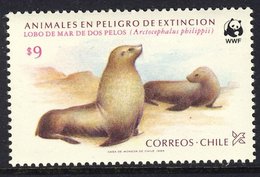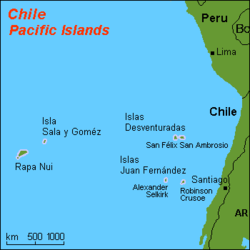Juan Fernandez fur seal
The Juan Fernandez fur seal (scientific name: Arctocephalus philippii) is one of 16 species of marine mammals in the family of Eared seals which include sea lions and fur seals. Together with the families of true seals and Walruses, Eared seals form the group of marine mammals known as pinnipeds.
Eared seals differ from the true seals in having small external earflaps and hind flippers that can be turned to face forwards. Together with strong front flippers, this gives them extra mobility on land and an adult fur seal can move extremely fast across the beach if it has to. They also use their front flippers for swimming, whereas true seals use their hind flippers.
Like other Eared seals, the male Juan Fernandez fur seal is considerably larger than the female.
Like other fur seals, the Juan Fernandez fur seal was long hunted for its skin and oil. Remarkably, the Juan Fernandez fur seal was considered extinct until it was happily rediscovered in 1965, although it nevertheless remains rare.
|
Conservation Status |
|
Scientific Classification Kingdom: Anamalia (Animals) |
Contents
Physical Description
Like most fur seals, this species has an elongated, slender body and a long, pointed snout and flippers. Adult males have a particularly long muzzle that may be slightly down-curved at the tip, and which ends in a large, bulbous, fleshy nose, creating a shark-like silhouette. Adult males also develop thicker and more muscular necks, surrounded by a mane of long, coarse, dark hair with silver tips, giving the mane a frosted appearance. The necks and fore-flippers of the males are usually scarred from fighting. The back and belly are dark, blackish-brown in males, while the crown down to the ears and nape to the shoulders sometimes appear silvery-grey, against a darker throat and neck. Adult females are grey-brown to dark brown above, and variably paler below, especially on the chest and underside of the neck, which can be creamy grey, and there may be areas of lighter colour on the face. Both sexes have whitish-cream whiskers.
The body is similar to that of most fur seals, slender and elongated, with males ranging from 150 to 200 cm, and females at about 140 cm in length. Weight of males is about 140 kg, and females weigh about 50 kg. All species of Arctocephalus have similar coloration. The under fur and bases of flippers are described as rich and chestnut brown in color. Males have a thick mane of long hair that is dark with white tips, giving the mane a frosted appearance. Males have a long pointed nose which is distinctive. Females have a noticeable grey-brown to dark brown coloration on the back but are paler below, especially on the chest and underside of the neck.
Reproduction
These social animals live in large, male-dominated groups in which breeding behaviour is highly territorial. Males hold aquatic and land territories. Females within each territory mate with the resident male. Juan Fernandez sea lions are polygynous in their mating system. As such, males will often fight fiercely to maintain their territories.
Breeding occurs from mid-November until the end of January, immediately after pupping, with most pups from the preceding breeding season being born from late November to early December. Thus, gestation takes a little under one year. Females give birth to a single pup, which they then nurse on land.
After around 11 days after birth, females leave their pups to feed at sea, and for the next seven to ten months, undergo long foraging trips of about 12 days in length, returning to nurse the pup for an average of five days at a time. The length of these feeding trips is exceptionally long for a fur seal, and leads to some of the longest intervals without suckling for any mammal. Fat and energy content of milk is the highest of any member of the family Otariidae examined, allowing young to grow rapidly despite long periods of fasting.
Lifespan/Longevity
The longevity of Juan Fernandez fur seals is unknown but may be similar to Antarctic fur seals, in which expected life span is 13 years for males, with females typically living about 23 years.
Behavior
The diet includes at least five varieties of squid, and there are reports that these fur seals also feed on various fishes and lobster. Sharks and killer whales are known to prey on Juan Fernandez fur seals.
These fur seals have the habit of resting in the water with heads down and hindflippers swaying out of the water, a behavior evident even in juveniles. Adults behaved aggressively towards a human diver on one expedition. Young Juan Fernandez fur seals play almost constantly in shallow tide pools and are often seen lunging at each other's heads and foreflippers.
Juan Fernandez fur seals are very vocal with calls ranging from a bark, usually when an animal moves or is playing, to a high-pitched scream often aimed at the approach of an intruder. Individuals may use a guttural cough if threatened. Females with pups will make a prolonged bawl. The communication is seemingly complex. Communication also occurs through visual and tactile cues and perhaps chemical cues, such as pheromones.
Distribution
Breeding occurs on isolated rocks and islets of the Juan Fernandez Archipelago and possibly San Felix / San Ambrosio island groups off the Chilean coast. Ten to fifteen adult and juvenile males have also been seen during the autumn and winter at Punta San Juan on the Chilean mainland
Habitat
When ashore, these fur seals are usually found on rocky and volcanic shorelines with boulders, cliffs, overhangs, and caves. There is a tendency to use caves or recesses, and individuals have been observed up to 25 metres from a cave entrance. Although these seals are often seen in the shallows of surrounding waters, adults generally forage for food in deeper water.
Juan Fernandez fur seals are usually found hauled out on rocks at the base of cliffs or ledges. They also have the tendency to use caves or recesses while on shore and have been seen 25 meters from a cave entrance. This habit may have saved them from hunters, as many of the caves are inaccessible to humans. Individuals are often seen active in the shallows, but adults generally forage in deep water.
Sharks and killer whales are known to attack other species of this genus. Juan Fernandez fur seals are fast and maneuverable swimmers and can seek refuge on land from these aquatic predators.
Although no exact interactions are known it can be assumed that Juan Fernandez fur seals would effect the populations of their aquatic prey, and that any stillbirths would help local waterfowl.
Food Habits
Juan Fernandez Fur Seals are reported to feed on cephalopods, such as squid, and on fish.
Conservation Status
After rediscovery, the species was given total protection by national Chilean legislation in 1978. This measure appears to have been successful as, since then, there has been an annual population increase of 16 to 17%, in spite of occasional illegal hunting.
Threats
Once abundant, this fur seal was heavily exploited by commercial sealers from the 17th to the 19th centuries for its pelt, blubber, meat and oil, and by the beginning of the 20th century it was believed to be extinct. When the species was rediscovered in 1965, just 200 individuals survived, but with conservation the population has since steadily increased to more than an estimated 12,000. However, despite being protected by the Chilean government, the Juan Fernandez fur seal is sometimes poached illegally for lobster bait, fur and meat. Occasional reports also exist of the seal becoming entangled in fishing nets and plastic waste. There is an additional concern that the seal may have to compete with fisheries for its food, and due to its limited size, the population is vulnerable and may suffer from a lack of genetic diversity.
Economic Importance for Humans
Juan Fernandez fur seals were used heavily by sealers in the late 1700s and early 1800s as a source of pelts, blubber, meat, and oil. Unfortunately this hunting lead to precipitous population declines and near extinction. There are no known adverse affects on humans although the possibility of competition with commercial fisheries has been noted in conjunction with conservation efforts.
Further Reading
- Arctocephalus philippii] Encyclopedia of Life (accessed April 5, 2009)
- Arctocephalus philippii, Handysides, D., 2004, Animal Diversity Web (accessed April 3, 2009)
- Juan Fernandez fur seal, Catalogue of Life (accessed November 24, 2009)
- Juan Fernandez fur seal, Seal Conservation Society (accessed April 3, 2009)
- The Pinnipeds: Seals, Sea Lions, and Walruses, Marianne Riedman, University of California Press, 1991 ISBN: 0520064984
- Encyclopedia of Marine Mammals, Bernd Wursig, Academic Press, 2002 ISBN: 0125513402
- Marine Mammal Research: Conservation beyond Crisis, edited by John E. Reynolds III, William F. Perrin, Randall R. Reeves, Suzanne Montgomery and Timothy J. Ragen, Johns Hopkins University Press, 2005 ISBN: 0801882559
- Walker's Mammals of the World, Ronald M. Nowak, Johns Hopkins University Press, 1999 ISBN: 0801857899
- Juan Fernandez fur seal, MarineBio.org (accessed April 4, 2009)
- Francis, J., D. Boness. 1991. The effect of thermoregulatory behavior on mating of A. philippii. Behaviour , 119: 104-126.
- Ochoa-Acuna, H., J. Francis, O. Oftedal. 1999. Influence of long intersuckling interval on composition of milk in the Juan Fernandez fur seal, A. philippii. Journal of Mammalogy , 80: 758-767.
- Juan Fernandez Fur Seal - Arctocephalus philippii, UNEP World Conservation Monitoring Center (accessed April 3, 2009)


